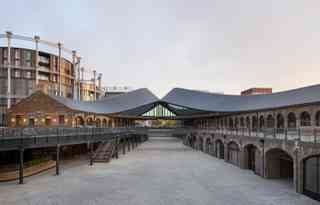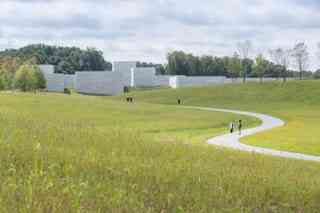August 12,2022
The 8 Best Buildings Completed in 2018
by David Stewart
In the world of architecture, 2018 was a fruitful year. Skylines expanded, famous works of art found homes on the walls of newly completed museums, and, finally, a memorial was built to honor and acknowledge victims of lynching in the United States. At its best, architecture answers a call to any given environment at any given time. Yet what makes some buildings better than others is a sense of timelessness. As the brilliant Bjarke Ingles once quipped, “Architecture is the art and science of making sure that our cities and buildings fit with the way we want to live our lives.” From a museum for the St. Louis Arch by Cooper Robertson to Snøhetta’s new Calgary Public Library, the structures erected in 2018 proved that our culture is one that is steadfast in preserving the past while hellbent on implementing the technologies of the future. And while it’s never easy to narrow down a list of the best buildings completed in any given year, we believe these eight are about as strong of a grouping as they come.

Coal Drops Yard, by Heatherwick Studio (London)
Thomas Heatherwick's latest design in central London is the perfect blend of new and old. The legendary designer transformed a pair of Victorian sheds that were once used for the storage and distribution of coal around London. The derelict buildings have been reborn thanks to Heatherwick's design, which was part of an expansive redevelopment of buildings and pedestrian spaces in the surrounding area. If anyone was unsure as to the bridge that connects new and old, Heatherwick confirms it with the buildings coming together, almost as if they were kissing, above a space pedestrians can walk through.

Gateway Arch Museum, by Cooper Robertson and James Carpenter Design Associates (St. Louis)
The St. Louis Arch is such an iconic American landmark that it justifiably needed a museum to tell its remarkable story. In 2018, architect Cooper Robertson and James Carpenter Design Associates spearheaded for a major, $380 million renovation of the park. The changes meant an expansion of the museum, the addition of a cafe, and the raising of the riverbank to prevent flooding.

Glenstone Expansion, by Thomas Phifer and Partners (Potomac, Maryland)
This year saw the newest addition to the Glenstone, a previously completed space that allows visitors to experience art, architecture, and nature in a way most museums could never offer. The latest section was the Pavilions, a 240,000-square-foot expansion increases the capacity for visitors from 25,000 to 100,000 annually, making it one of the world's largest private museums. The expansion consists of a series of discrete masonry forms that house a single artist's work. Each structure will have a window facing a central courtyard, while one room will face outwards toward the landscape, gently tugging the museumgoers' attention to reveal the splendors of Potomac's landscape.
Calgary Library, by Snøhetta (Calgary)
Calgary's new library isn't merely a space to house books and computers but a building that better connects residents to the city. Located at the intersection between Downtown Calgary and the East Village, the Snøhetta-designed structure lifts to allow the existing Light Rail Transit Line to pass through. The geometrically designed exterior draws residents into activities occurring inside the library, while those upper levels (which aren't as open to the public to see from outside) allow for a more quiet, traditional library experience.
V&A Museum of Design Dundee, by Kengo Kuma (Dundee, Scotland)
Designed by Kengo Kuma, Scotland's first-ever museum dedicated to design is a building like no other. The Japanese architect is no stranger to abstract building, as is evident in his design of Dundee's newest structure. It is inspired by the spectacular cliffs that surround the country, which is where the sharply angular façade comes into play. Whether visitors walk into the building or simply walk around it, they will feel the experience of being in or near an incredible structure.
The National Memorial for Peace and Justice, by MASS Design Group (Montgomery, Alabama)
Arguably the most powerful building to be completed in 2018, the opening of the first-ever national memorial to the victims of lynching occurred at a time when Confederate monuments became such a topic of debate in America. Created by the Equal Justice Initiative and designed by the Boston-based firm MASS Design Group, The National Memorial for Peace and Justice will surely be an educational, if not harrowing, experience for every visitor. At the beginning of the memorial, patrons walk alongside dark red columns (which include both the names of victims and the counties where these unthinkable events took place). Slowly, the ground slants downward, while the columns remain at the same level, eventually hanging above the visitors in a manner that evokes the lynchings that occurred around the country.
National Veterans Memorial and Museum, by Allied Works Architecture (Columbus, Ohio)
Columbus's National Veterans Memorial and Museum is a beautifully understated structure meant to honor the country's veterans in an appropriately somber manner. Much like those it's honoring, the structure has a dignified form that appears to be organically grown from the ground. Designed Allied Works Architecture, the building will house artifacts, multimedia exhibits, and installations to remind visitors of all that the nation's veterans have sacrificed.
The Menil Drawing Institute, by Johnston Marklee (Houston)
Though it was established in 2008 and held major exhibitions for artists such as Jasper Johns, The Menil Drawing Institute has finally had its first-ever permanent space dedicated to the exhibition, conservation, and study of modern and contemporary drawings. Designed by the Los Angeles firm Johnston Marklee, the space evokes a warm feeling that can only be established by a structure that appears to be part home, part museum. Inside, the firm struck a delicate balance of providing ample natural light to the space while ensuring overexposure would not harm any of the papers on exhibit.






